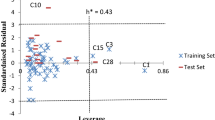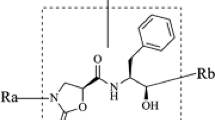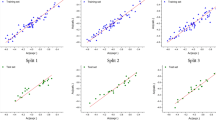Abstract
In pursuit of better anti-HIV drugs, quantitative structure-activity relationship (QSAR) studies were performed on a series of aryl sulfonamide HIV protease inhibitors using Win CAChe 6.1. Multiple linear regression analysis was performed to derive QSAR models, which were further evaluated for statistical significance and predictive power by internal and external validation. The QSAR model indicates that the thermodynamic descriptors (heat of formation, log P, and molar refractivity) and steric descriptor (solvent assessable surface area) play an important role for the anti-HIV activity. The results of the present study may be useful on the designing of more potent anti-HIV agents.


Similar content being viewed by others
References
Barre-Sinoussi F, Chermann JC, Rey F, Nugeyre MT, Chamaret S, Gruest J, Dauguet C, Axler-Blin C, Vezinet-Brun F, Rouzioux C, Rozenbaum W, Montagnier L (1983) Isolation of a T-lymphotropic retrovirus from a patient at risk for acquired immune deficiency syndrome (AIDS). Science 220:868–871
Chrusciel RA, Strohbach JW (2004) Non-peptidic HIV protease inhibitors. Curr Top Med Chem 4:1097–1114
Gallo RC, Salahuddin SZ, Popovic M, Shearer GM, Kaplan M, Haynes BF, Palker TJ, Redfield R, Oleske J, Safai B (1984) Frequent detection and isolation of cytopathic retroviruses (HTLV-III) from patients with AIDS and at risk for AIDS. Science 224:500–503
Garg R, Gupta SP, Gao H, Mekapati SB, Debnath AK, Hansch C (1999) Comparative quantitative structure activity relationship studies on anti-HIV drugs. Chem Rev 99:3525–3602
Golbraikh A, Tropsha A (2002) Beware of q2! J Mol Graph Model 20:269–276
Gottlinger HG, Sodroski JG, Haseltine WA (1989) Role of capsid precursor processing and myristoylation in morphogenesis and infectivity of human immunodeficiency virus type 1. Proc Natl Acad Sci.USA 86:5781–5785
Gupta SP, Babu MS, Garg R, Sowmya S (1998) Quantitative structure-activity relationship studies on cyclic urea-based HIV protease inhibitors. J Enzyme Inhib 13:399–407
Gayathri P, Pande V, Sivakumar R, Gupta SP (2001) A quantitative structure-activity relationship study on some HIV-1 protease inhibitors using molecular connectivity index. .Bioorg Med Chem 9:3059–3063
Hanch C, Leo A (1995) Exploring QSAR, Fundamentals and Applications in Chemistry and Biology; American Chemical Society: Washington, DC, 90–100
Henderson LE, Sowder RC, Copeland TD, Oroszlan S, Benveniste RE (1990) Gag precursors of HIV and SIV are cleaved into six proteins found in the mature virions. J Med Primatol 19:411–419
Kohl NE, Emini NA, Schleif WA, Davis LJ, Heimbach JC, Dixon RAF, Scolnick EM, .Sigal IS (1988) Active human immunodeficiency virus protease is required for viral infectivity. Proc Natl Acad Sci USA 85:4686–4690
Kubinyi H (1993) In: Methods and Principles in Medicinal Chemistry, Mannhold R, Krogsgaard-Larsen R, Timmerman H (Eds) VCH: Weincheim, 1:91–95
Kurup A, Mekapati SB, Garg R, Hansch C (2003) HIV-1 protease inhibitors: a comparative QSAR analysis. Curr Med Chem 10:1679–1688
McQuade TJ, Tomasselli AG, Liu L, Karacostas V, Moss B (1990) A synthetic HIV-1 protease inhibitor with antiviral activity arrests HIV-like particle maturation. Science 247:454–456
Miller JF, Brieger M, Furfine ES, Hazen RJ, Kaldor I, Reynolds D, Sherrill RG, Spaltenstein A (2005) Novel P1 chain-extended HIV protease inhibitors possessing potent anti-HIV activity and remarkable inverse antiviral resistance profiles. Bioorg Med Chem Lett 15:3496–3500
Peng C, Ho BK, Chang TW, Chang NT (1989) Role of human immunodeficiency virus type 1-specific protease in core protein maturation and viral infectivity. J Virol 63:2550–2556
Ravichandran V, Agrawal RK (2007) Predicting anti-HIV activity of PETT derivatives: CoMFA approach. Bioorg Med Chem Lett 17:2197–2202
Sahu KK, Ravichandran V, Mourya VK, Agrawal RK (2007) QSAR analysis of caffeoyl naphthalene sulphonamide derivatives as HIV-1 integrase inhibitors. Med Chem Res 15:418–430
Seelmier S, Schmidt H, Turk V, Helm VDK (1988) Human immunodeficiency virus has an aspartic-type protease that can be inhibited by pepstatin A. Proc Natl Acad Sci USA 85:6612–6616
Vogt VM (1996) Proteolytic processing and particle maturation. Curr Top Microbiol Immunol 214:95–131
Wagener M, Sadowski J, Gasteiger J (1995) Autocorrelation of molecular surface properties for modeling corticosteroid binding globulin and cytosolic Ah receptor activity by neural networks. J Am Chem Soc 117:7769–1775
Wold S, Eriksson L (1995) In: Chemometrics Methods in Molecular Design. Waterbeemed H (ed) VCH: Weincheim, 309–318
Acknowledgments
One of the authors (VR) is thankful to AICTE, New Delhi for providing a (QIP) fellowship and the authors would like to thank Mr. Nowley of the Government College of Pharmacy, Auranagabad, India for his valuable help.
Author information
Authors and Affiliations
Corresponding author
Rights and permissions
About this article
Cite this article
Ravichandran, V., Jain, P.K., Mourya, V.K. et al. QSAR study on some arylsulfonamides as anti-HIV agents. Med Chem Res 16, 342–351 (2007). https://doi.org/10.1007/s00044-007-9034-7
Received:
Accepted:
Published:
Issue Date:
DOI: https://doi.org/10.1007/s00044-007-9034-7




